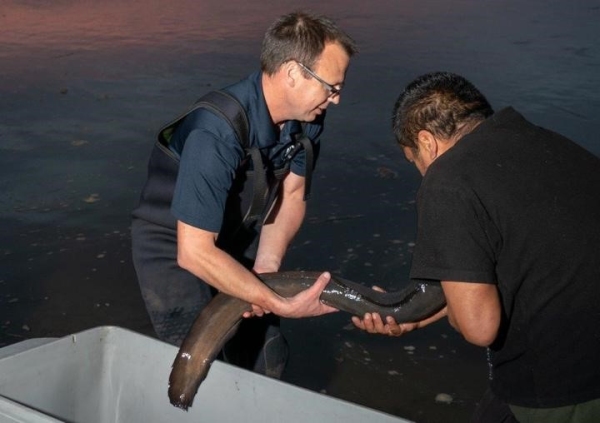NIWA freshwater scientists are pinning their hopes of solving an age-old mystery on 10 female longfin eels who have now begun an epic journey to their spawning grounds somewhere in the Pacific Ocean.
The eels, which live for about 60 years but can get to as old as 100, were caught in the Waikato River and fitted with the tags at Te Kauwhata last month. Eels develop a blue ring around the eye immediately before their migration begins, making it easier to sort the emigrants from the stayers.
NIWA freshwater ecologist Dr Paul Franklin says not knowing where the eels spawn has long been a gap in the knowledge about their life cycle.
“We know from previous NIWA research that the most likely breeding zone is in a large area between Tonga and New Caledonia, but we are hoping this project will give us a much more precise location.”
Dr Don Jellyman, also from NIWA, made the first attempts to track longfin eels back in the early 2000s. The pop-up archival satellite tags used then were bigger and heavier than modern versions, and Don had limited success with the ten he deployed.
One came off about 1000 kilometres northeast of New Zealand. The most successful tag was released from an eel after a journey of 2500 kilometres, popping up 700 kilometres east of New Caledonia.
If scientists are right about the likely breeding area, it takes eels several months to get there. They stop feeding once they begin migrating and travel up and down in the water column as they migrate – spending daytime at depths of up to 800 m and nightime near the surface.
Once the eels arrive at their spawning ground, they spawn and then die. Their larvae are transported via ocean currents to New Zealand to grow and mature in fresh waters.
“Knowing the location of eel spawning grounds has been a challenge worldwide. For our New Zealand longfin eel, we just need to find that final bit of information to nail down where they go. Hopefully we may be close to solving that by Christmas,” Dr Franklin said.
Each of the eels, which are endemic to New Zealand and can grow up to two metres long and weigh up to 25kg.
NIWA scientists are also trying to find out more about the eels’ early life history, including larval migration routes. They want to learn if the numbers making it to New Zealand are affected by processes happening during their marine life. Longfin eels are classified as at risk and declining.
One life-history project involves studying the ear bones of the glass eels – the stage when they are about 7cm long. The ear bones add a layer of calcium carbonate each day, like ring tree rings, which can provide information on growth, diet and movement.

